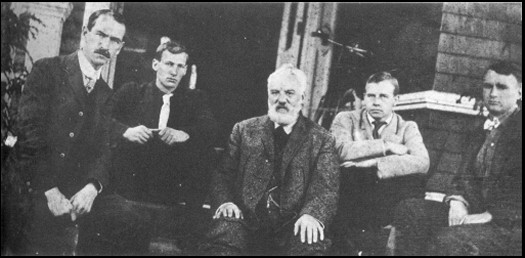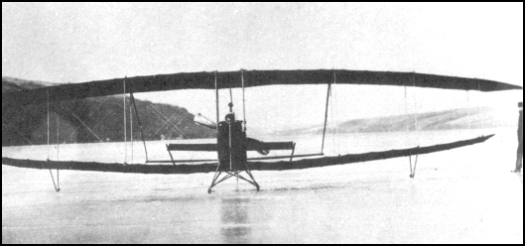
1882-1948 |
 |
| The Bell Family & National Geographic Society |
|
An early flight enthusiast, Dr. Alexander Graham Bell (center) formed an experimental group in 1907 to
"build a practical aeroplane that will carry a man." Shown with Bell at his Nova Scotia home are (left to right)
Glenn H. Curtiss, John McCurdy, F.W. Baldwin, and Lieutenant Thomas E. Selfridge. The Story of the Early Birds by Henry Serrano Villard |
|
Bell had gathered around him at Baddeck a group of bright young men, including two recent graduates in mechanical engineering of the University of Toronto: Frederick Walker ("Casey") Baldwin (no relation to the balloonist) and John A. D. McCurdy, son of an inventor, who was to mature into one of America's foremost aviators. |
 |
| Air Force Museum |
|
The first flying machine developed by the Bell group was the Red Wing, a biplane with the propeller
located behind the wing. It is shown here with pilot "Casey" Baldwin before its flight at Lake Keuka, New York, on March 12, 1908. |
|
The Red Wing was followed in a few weeks by a resplendent White Wing, designed by Baldwin. This model, because the ice had melted, was put on a tricycle undercarriage and taken for trials to an abandoned race-track known as Stony Brook Farm. It was soon apparent that to get the Whiite Wing into the air was one thing, but to get back down without wrecking the machine was quite another. Smash followed smash in discouraging succession---fortunately with no injuries save to the feelings of the operator. "It seemed one day that the limit of hard luck had been reached," wrote Curtiss of these first ventures, "when, after a brief flight and a somewhat rough landing, the machine folded up and sank down on its side, like a wounded bird, just as we were feeling pretty good over a successful landing without breakage." The only way to learn was the hard way: by trial and repair, by study of stresses and strains, by provisional changes in details of construction. But on May 22, the White Wing, with Curtiss at the controls, flew a distance of 1017 feet in 19 seconds and actually landed intact in a ploughed field outside the old racetrack. It was cause for elation---and for the prompt construction, under Curtiss's direction, of a bigger, better, prize-winning plane: the June Bug. The Story of the Early Birds by Henry Serrano Villard |
|
Highlights In the History of Canadian Aviation |
|
Frederick W. Baldwin died at his home near Baddeck on August 7, 1948, aged sixty-six The Story of the Early Birds by Henry Serrano Villard |
|
Recommended Further Reading: CONTACT, The story of the Early Birds by Henry Serrano Villard Thomas Y. Crowell Company |


|